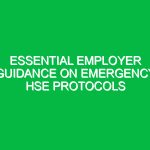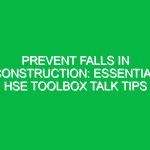Introduction
In the realm of Health, Safety, and Environment (HSE), being prepared for emergencies is paramount. One key component of this preparedness is the 1st aid box checklist. This checklist serves as a Comprehensive Guide to ensure that first aid supplies are readily available and organized to address a variety of potential emergencies. Whether in a workplace setting, at home, or during outdoor activities, having a well-stocked first aid kit can mean the difference between a minor incident and a serious situation. In this article, we will delve into the essential components of an effective 1st aid box checklist, the importance of maintaining it, and how it aligns with HSE practices.
The Importance of a 1st Aid Box Checklist in HSE
A well-prepared 1st aid box is not merely a collection of random items; it is a strategic asset in health and Safety management. The significance of a 1st aid box checklist lies in its ability to facilitate quick and effective responses to injuries or medical emergencies. Here are some reasons why it’s critical in the HSE context:
- Immediate Response: Emergencies often occur without warning. A complete first aid box enables immediate attention to injuries, potentially saving lives.
- Regulatory Compliance: Many workplaces are legally required to maintain a first aid kit. Adhering to the 1st aid box checklist helps organizations comply with Regulations and Standards.
- Promoting Safety Culture: A well-stocked first aid box reflects an organization’s commitment to employee welfare and safety, fostering a culture of preparedness.
Key Components of a 1st Aid Box Checklist
Creating an effective 1st aid box checklist involves understanding the essential items that should be included. The following components are crucial for any first aid kit, particularly within HSE settings:
1. Basic Supplies
These items are fundamental for treating minor injuries and should always be present in a 1st aid box:
- Adhesive bandages (various sizes)
- Sterile gauze pads
- Adhesive tape
- Antiseptic wipes or solution
- Scissors
- Disposable gloves
- Tweezers
- Instant cold packs
2. Medications
Having a selection of over-the-counter medications can be beneficial for immediate relief from common ailments:
- Pain relievers (e.g., aspirin, ibuprofen)
- Antihistamines for allergic reactions
- Antacids for indigestion
3. Specialized Equipment
In specific environments, particularly industrial or outdoor settings, certain specialized items may be necessary:
- Burn dressings
- Eye wash or saline solution
- Emergency blanket
- CPR face shield or mask
4. Documentation
Documentation is often overlooked but is essential for providing complete care:
- First aid manual or instructions
- Emergency contact numbers
- Accident report forms
Best Practices for Maintaining Your 1st Aid Box
Simply having a 1st aid box checklist isn’t enough; regular Maintenance ensures that the items remain effective and usable:
1. Regular Inspections
Schedule routine checks to ensure all items are present, in good condition, and within their expiration dates. This practice helps to identify shortages or expired supplies before an emergency arises.
2. Training and Preparedness
Ensure that all employees or family members are informed about the location of the first aid box and are trained in basic first aid Procedures. This knowledge empowers individuals to act swiftly in emergencies.
3. Customization Based on Risks
Tailor your 1st aid box checklist to address specific risks associated with your environment. For instance, a construction site may require additional items like splinting materials, while a laboratory setting may necessitate specialized chemical spill kits.
Potential Hazards and Risks
Understanding the potential Hazards in your environment is essential for effective risk management.
1. Workplace Hazards
In a workplace, various risks can arise, such as slips and falls, cuts, and Burns. Each of these scenarios necessitates a specific response and corresponding supplies in the first aid box.
2. Home Hazards
In a domestic setting, common risks include kitchen injuries, slips in the bathroom, or accidents during home repairs. Adjusting your 1st aid box checklist to reflect these realities ensures you’re prepared for these typical incidents.
Regulations and Standards
The legal landscape surrounding first aid kits varies by region and industry, but several standards are universally recognized.
1. OSHA Regulations
In the United States, the Occupational Safety and Health Administration (osha) mandates that employers provide appropriate first aid supplies. Understanding these regulations is crucial for compliance and can dictate specific requirements for your 1st aid box checklist.
2. ISO Standards
Internationally, the International Organization for Standardization (ISO) offers guidelines for Workplace Safety, including requirements for first aid kits. Familiarity with these standards can enhance your organization’s approach to health and safety.
Real-Life Examples
Consider a scenario where an employee at a manufacturing plant suffers a minor injury from a machine. The availability of a well-stocked 1st aid box enables a quick response, allowing a colleague to apply an adhesive bandage and antiseptic before the employee receives further medical attention. This prompt action minimizes the risk of infection and promotes a safe workplace culture.
Another example involves a family camping trip. When a child accidentally cuts their leg while playing, having a 1st aid box equipped with gauze, antiseptic wipes, and adhesive bandages allows the parents to address the injury immediately, preventing further complications.
Conclusion
In conclusion, a comprehensive 1st aid box checklist is a vital element of Health, Safety, and Environment strategies. By ensuring that your 1st aid box is well-stocked, regularly inspected, and tailored to your specific risks, you enhance your preparedness for emergencies. The importance of a 1st aid box transcends mere compliance with regulations; it embodies a proactive approach to health and safety that fosters a culture of care and responsibility.
As we have explored, maintaining an effective 1st aid box not only addresses immediate health concerns but also contributes significantly to overall safety and well-being within any environment. Take the time to evaluate your 1st aid box checklist today and ensure that you are ready for whatever emergencies may arise.


